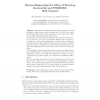Free Online Productivity Tools
i2Speak
i2Symbol
i2OCR
iTex2Img
iWeb2Print
iWeb2Shot
i2Type
iPdf2Split
iPdf2Merge
i2Bopomofo
i2Arabic
i2Style
i2Image
i2PDF
iLatex2Rtf
Sci2ools
IACR
2016
2016
Reverse-Engineering the S-Box of Streebog, Kuznyechik and STRIBOBr1
The Russian Federation’s standardization agency has recently published a hash function called Streebog and a 128-bit block cipher called Kuznyechik. Both of these algorithms use the same 8-bit S-Box but its design rationale was never made public. In this paper, we reverse-engineer this S-Box and reveal its hidden structure. It is based on a sort of 2-round Feistel Network where exclusive-or is replaced by a finite field multiplication. This structure is hidden by two different linear layers applied before and after. In total, five different 4-bit S-Boxes, a multiplexer, two 8-bit linear permutations and two finite field multiplications in a field of size 24 are needed to compute the S-Box. The knowledge of this decomposition allows a much more efficient hardware implementation by dividing the area and the delay by 2.5 and 8 respectively. However, the small 4-bit S-Boxes do not have very good cryptographic properties. In fact, one of them has a probability 1 differential. We then gene...
Biometrics | IACR 2016 |
| Added | 03 Apr 2016 |
| Updated | 03 Apr 2016 |
| Type | Journal |
| Year | 2016 |
| Where | IACR |
| Authors | Alex Biryukov, Léo Perrin, Aleksei Udovenko |
Comments (0)

